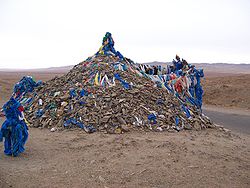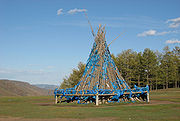
Ovoo
Encyclopedia

Shamanism
Shamanism is an anthropological term referencing a range of beliefs and practices regarding communication with the spiritual world. To quote Eliade: "A first definition of this complex phenomenon, and perhaps the least hazardous, will be: shamanism = technique of ecstasy." Shamanism encompasses the...
cairn
Cairn
Cairn is a term used mainly in the English-speaking world for a man-made pile of stones. It comes from the or . Cairns are found all over the world in uplands, on moorland, on mountaintops, near waterways and on sea cliffs, and also in barren desert and tundra areas...
found in Mongolia
Mongolia
Mongolia is a landlocked country in East and Central Asia. It is bordered by Russia to the north and China to the south, east and west. Although Mongolia does not share a border with Kazakhstan, its western-most point is only from Kazakhstan's eastern tip. Ulan Bator, the capital and largest...
, usually made from rocks or from wood. Ovoos are often found at the top of mountains and in high places, like mountain passes. They serve mainly as religious sites, used in worship of the mountains and the sky as well as in Buddhist ceremonies, but often are also landmarks.
When travelling, it is custom to stop and circle an ovoo three times in clockwise direction, in order to have a safer journey. Usually, rocks are picked up from the ground and added to the pile. Also, one may leave offerings in the form of sweets, money, milk, or vodka. If one is in a hurry while travelling and does not have time to stop at an ovoo, honking of the horn while passing by the ovoo will suffice.
Ovoos are also used in mountain- and sky-worshipping
Tengriism
Tengriism is a Central Asian religion that incorporates elements of shamanism, animism, totemism and ancestor worship. Despite still being active in some minorities, it was, in old times, the major belief of Turkic peoples , Bulgars, Hungarians and Mongols...
ceremonies that typically take place at the end of summer. Worshippers place a tree branch or stick in the ovoo and tie a blue khadag, a ceremonial silk scarf symbolic of the open sky and the sky spirit Tengger, or Tengri, to the branch. They then light a fire and make food offerings, followed by a ceremonial dance and prayers (worshippers sitting at the northwest side of the ovoo), and a feast with the food left over from the offering.
During Mongolia's Communist period, ovoo worship was officially prohibited along with other forms of religion, but people still worshipped clandestinely anyway.
See also

- Bayan-Ovoo, BayankhongorBayan-Ovoo, BayankhongorBayan-Ovoo is a sum of Bayankhongor Province in southern Mongolia....
- Bayan-Ovoo, KhentiiBayan-Ovoo, KhentiiBayan-Ovoo is a sum of Khentii Province in eastern Mongolia....
- Bayan-Ovoo, ÖmnögoviBayan-Ovoo, ÖmnögoviBayan-Ovoo is a sum of Ömnögovi Province in southern Mongolia....
- Mandal-Ovoo, ÖmnögoviMandal-Ovoo, ÖmnögoviMandal-Ovoo is a sum of Ömnögovi Province in southern Mongolia....
- Saikhan-Ovoo, DundgoviSaikhan-Ovoo, DundgoviSaikhan-Ovoo is a sum of in southern Mongolia. Sum center is on the single perennial river of Dundgovi Province - Ongi gol river which is the tenth longest river of Mongolia with an overall length of 435 km....
- Tsagaan-Ovoo, DornodTsagaan-Ovoo, DornodTsagaan-Ovoo is a sum of Dornod Province in eastern Mongolia....
- Bayan OboBayan OboBayan Obo Mining District, , or Baiyun-Obo or Baiyun'ebo, is a mining town in the west of Inner Mongolia, People's Republic of China. It is under the administration of Baotou City, more than to the south....
, in Inner Mongolia
Similarities with:
- CairnCairnCairn is a term used mainly in the English-speaking world for a man-made pile of stones. It comes from the or . Cairns are found all over the world in uplands, on moorland, on mountaintops, near waterways and on sea cliffs, and also in barren desert and tundra areas...
- InukshukInukshukAn inuksuk is a stone landmark or cairn built by humans, used by the Inuit, Inupiat, Kalaallit, Yupik, and other peoples of the Arctic region of North America. These structures are found from Alaska to Greenland...
External links
- Culture Mongolia: Ovoos
- This is Mongolia: Ovoos
- Ovoos - in Mongolian Buddhism
- 2007 Mongolian Lunar New Year account - seeing in the new year (Tsagaan SarTsagaan SarTsagaan Sar , white moon or white month) is the lunisolar New Year festival of the Mongols. Today, Mongols are found in Mongolia, Inner Mongolia, Buryatia and Kalmykia. It is often celebrated around the same time as the Chinese New Year...
) at the Khiimoryn Ovoo - Alliance of Religions and Conservation
- pbase.com: Ovoo picture - with nine horse skulls
- Tengerism.org - Siberian and Mongolian shaman traditions

